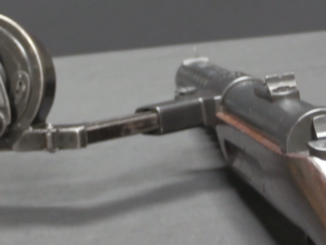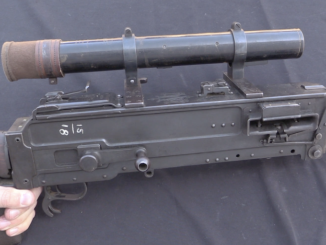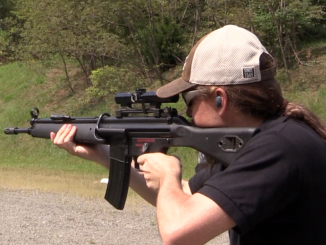Gustloff was a large industrial concern in Germany which made many different weapons for the military. In addition to these, its attempted to market a small-caliber pistol for police or SS use. This pistol used an alloy frame (with steel inserts for durability in crucial areas) and steel slide, with a simple blowback mechanism and a fixed barrel similar to the Walther PPK. It has a shrouded hammer, and double-action trigger mechanism. One particularly unusual element to the gun was its safety lever, which functioned to actually remove tension from the hammer spring when engaged. Ultimately, it appears that 200-300 were made for evaluation by various groups, but no contracts resulted. The pistols that were made saw little or no combat use, and were often brought back as souvenirs by occupying American soldiers. This example is a very early one, serial number 13.
Related Articles

Submachine Guns
Schmeisser’s MP-18,I – The First True Submachine Gun

Aircraft MGs
Parabellum 1914/17: Germany’s Ultimate Aircraft Maxim
Forgotten Weapons merino wool hoodies from Varusteleka: https://www.varusteleka.com/en/product/forgotten-weapons-sarma-merino-wool-hoodie/72488 The DWM company in Germany had a license on the Maxim gun design prior to World War One. They produced the rather old-fashioned MG08 for the German […]

Select-fire Rifles

Overall, it seems a lot like the Sauer 38H except for that interesting “dry-fire” safety. The takedown method looks very much like it might have been the inspiration for that of the Glock pistols and the WaltherP99/S&W SW99 and S&W Sigma series.
Give the frame a nice polishing job and do the slide in a goldtone Metalife or similar finish, and it would look even more like a lot of the “ladies’ guns” being marketed today than it does already.
In fact, this design would probably still be competitive today, especially in its existing .32 ACP or in .380, both of which seem to be regaining popularity with people who want a CCW pocket autopistol with some authority, but aren’t quite ready for the sharp kick and yippy report of a sub-compact 9 x 19mm.
Heck, I’d buy one.
cheers
eon
Frame seems made of zamak and some sources state that it was also made with steel frames. Slide seems made via heavy pressing process and longitidunal recesses under the gripping serrations support this. The breechblock should be resistance welded or hard soldered into its place. Double action triger work seems confusing since safety lever takes off the compression of stretch type main spring. Frame mounted safety may be accepted as an advantage over on the slide mounted Walthers but, over all construction does not seem as giving any superiority over these well known, tried tested handguns.
Stretch type main springs also are inferior than compression type samples especialy on wet field conditions.
The use of slave labor in Gustloff Werke facilities is interesting. I had a Mauser K98k that originated from Gustloff Werke. I shot it a few times and realized, when comparing it with other mil-spurs, that it wasn’t very accurate. I just couldn’t work out why until I looked down the front of the bore and saw that it had no rifling for the first cm or so. Could it be this was done as a form of industrial sabotage by the slave laborers?
Sabotage such as this was widespread in the German Reich. If we look at the Vengeance Weapons, which were manufactured largely – almost exclusively – by slave labor – many of the inaccuracies that came from their firing was from the slave laborers urinating on the gyroscopes and ruining what was a very fragile system because of the acids in their urine and not from any faults in the overall design.
That sounds like it was counterbored, which is a common procedure to improve the accuracy of a rifle with a damaged muzzle.
The Gustloff Werke was originally called Simson & Co. and founded by the Jewish brothers Löb and Moses Simson. In 1936 the Simson family fled the country and the Nazis took over the factory. Its main products at the time were actually motorcycles, cars and bicycles and weapons became the main product only after the Nazi takeover.
In a typical Nazi sick sense of humor, the company was named Gustloff-Werke – Waffenwerk Suhl in 1939 in honor of the Swiss (born German) Nazi Wilhelm Gustloff, who had been assassinated by a Croatian Jew David Frankfurter in 1936. Gustloff was a martyr to the cause in the minds of the Nazis. (Frankfurter was released from a Swiss prison in 1945 and later became an Israeli Army officer.)
Wow, short trigger pull.
The “decock” motion of the safety lever is towards the rear…awkward. So to ready the gun to fire from a safe condition, you have to cock the mainspring with the safety lever?
Decompression lever drawn to rear should disconnect trigger and sear engagement but, if sear escapes Hammer engagement through a dropping or impacting force, the hammer can only move forward to a stopping element under weak mainspring tension and, if the compession Lever is taken forwards, the manually actuated trigger will cock and release the hammer in double action mode. Forward actuating of compession/decompression lever should be needed for sufficient igniting power.
Interesting how it’s got a finger rest built into the bottom of the grip, requiring that curved floorplate to the mag.
As for the safety, I have to say I prefer the Sauer 38H’s decock/recock lever. And am mystified why that idea hasn’t become standard for shrouded-hammer pistols.
As the decompression lever is pulled back, it should disengage the trigger and sear engagement; however, if the sear escapes the hammer engagement due to a force that drops or impacts it, the hammer can only advance to a stopping element when the mainspring tension is insufficient.